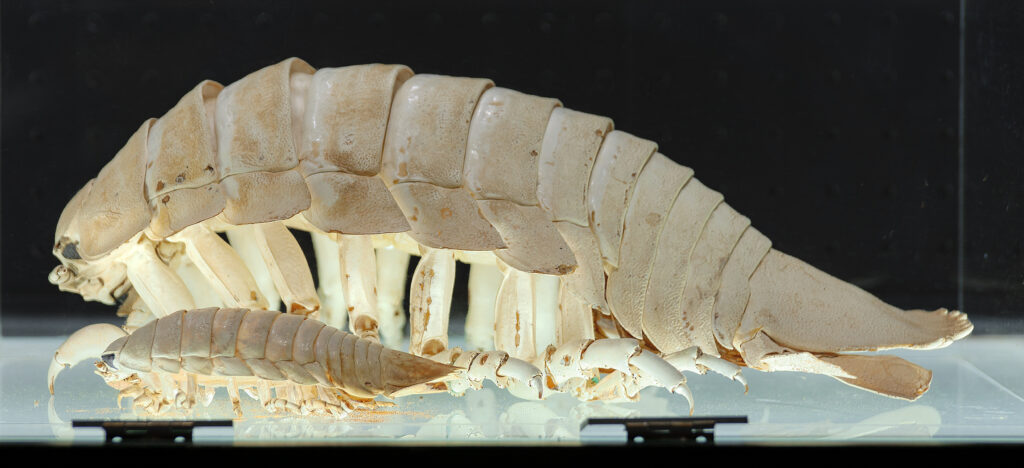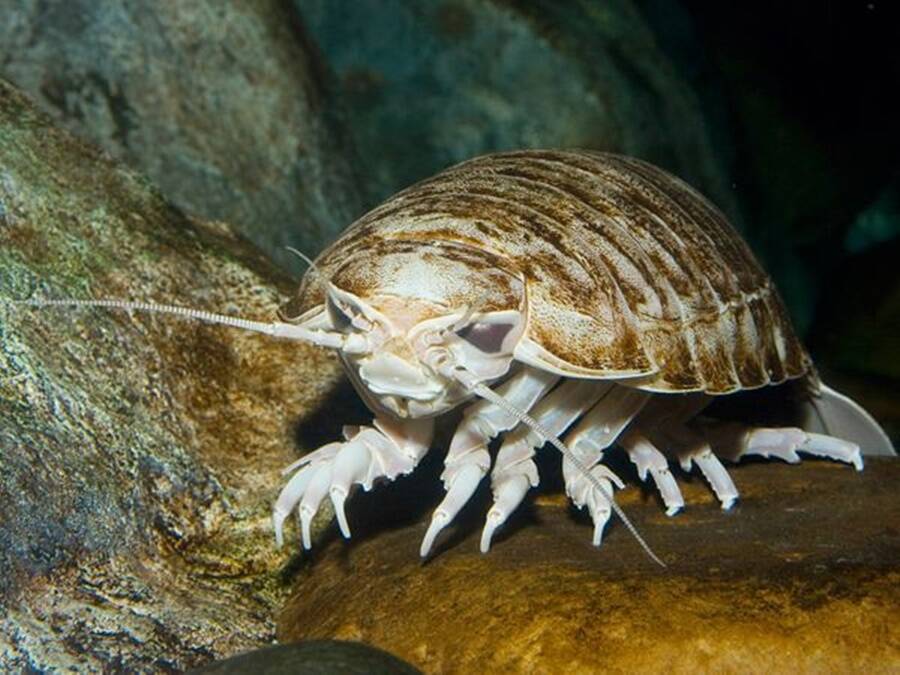Imagine descending into the murky abyss of the ocean, where sunlight fades into oblivion and the weight of the water presses down like a heavy shroud. Here, in this haunting world of perpetual darkness, lies a creature that seems plucked from the pages of a sci-fi epic: the Giant Isopod. Often portrayed as a relic of ancient times or a monstrous denizen of the deep, this colossal cousin of the humble pill bug continues to captivate and intrigue both scientists and the public. But beneath its imposing exterior lies a tale far more compelling than mere sensationalism. Let’s embark on a journey into the abyss and unveil the truth about the Giant Isopod.

Realm of Shadows: Where Titans Roam

Source:https://www.montereybayaquarium.org
Contrary to popular belief, Giant Isopods (Bathynomus giganteus) are not solitary overlords reigning over the ocean floor. Instead, they find solace in the darkness of the bathypelagic zone, a realm spanning from 1,000 to 4,000 meters (3,300 to 13,100 feet) beneath the surface. In this vast expanse of frigid waters, shrouded in perpetual twilight, these colossal crustaceans make their home.
Measuring up to 37 centimeters (15 inches) in length, they dwarf their terrestrial counterparts. But their size is just the beginning of their remarkable features. Their sturdy, segmented bodies are shielded by armor-like plates, their multitude of legs propelling them effortlessly across the seabed, while their compound eyes catch the faintest glimmers of bioluminescence in the depths. Yet, it is their massive mandibles, capable of crushing through the toughest shells and bones, that truly command attention.
However, before casting them as fearsome predators, consider this: despite their formidable appearance, Giant Isopods are primarily scavengers. They spend their days scouring the ocean floor, guided by their acute sense of smell, in search of fallen creatures—whale carcasses, fish skeletons, and other debris that drifts down from above.

https://www.aquariumofpacific.org/
Tools of Survival: Beyond Mighty Jaws
While their mandibles are indeed impressive, the Giant Isopod possesses a plethora of other adaptations that enable it to thrive in the abyss. Picture rows of delicate, hair-like structures covering its body. These aren’t merely ornamental; they serve as sensory organs, detecting chemical cues and water currents, aiding the isopod in navigation and foraging.
Then there are their seven pairs of legs—each uniquely shaped and equipped for navigating the uneven terrain of the seabed. Some legs boast hooks for gripping, while others are paddle-shaped, facilitating short bursts of swimming. Remarkably, these legs may also play a role in detecting vibrations, alerting the isopod to the presence of nearby prey or predators.
And let’s not forget their gill chambers—specialized structures that allow the Giant Isopod to extract oxygen from the cold, low-oxygen environment of the deep sea, a vital adaptation for survival in this harsh realm.
Mysteries of the Abyss: Unveiling the Life of the Giant Isopod

https://oceanconservancy.org/
Much of the Giant Isopod’s life remains shrouded in mystery. While scientists believe they are oviparous, laying eggs that hatch into planktonic larvae, details about their mating habits, parental care, and lifespan continue to elude us. And while they are typically solitary creatures, occasional aggregations around food sources hint at a complexity to their social behavior that we have yet to fully understand.
From the Depths to Headlines: Misunderstood Giants

https://allthatsinteresting.com/
Though often portrayed as monstrous beasts, Giant Isopods pose no real threat to humans. Their deep-sea habitat and scavenging nature keep them far removed from our world. In truth, they are remarkable examples of deep-sea adaptation, playing a crucial role in the decomposition of organic matter and the delicate balance of the ecosystem.
Yet, like so many inhabitants of the deep, these enigmatic creatures face threats from human activities. Deep-sea fishing can inadvertently capture them, while pollution poses potential dangers to their habitat. As we strive to learn more about these giants, it is imperative that we understand and address these threats to ensure their conservation.
Beyond the Fear: A Call to Discovery

Source:https://www.worldbook.com/
Giant Isopods are more than mere “sea monsters.” They are survivors, scavengers, and fascinating enigmas of the deep. By delving into their adaptations, life cycle, and ecological role, we gain a deeper appreciation for the diversity and wonder of our planet’s oceans.
As we peel back the layers of mystery surrounding these remarkable creatures, let us move beyond sensationalism and embrace a genuine understanding and appreciation for the wonders that lie hidden in the darkness of the abyss. For the ocean’s depths hold countless mysteries waiting to be unveiled, and the Giant Isopod stands as a testament to the awe-inspiring beauty of the deep sea.












